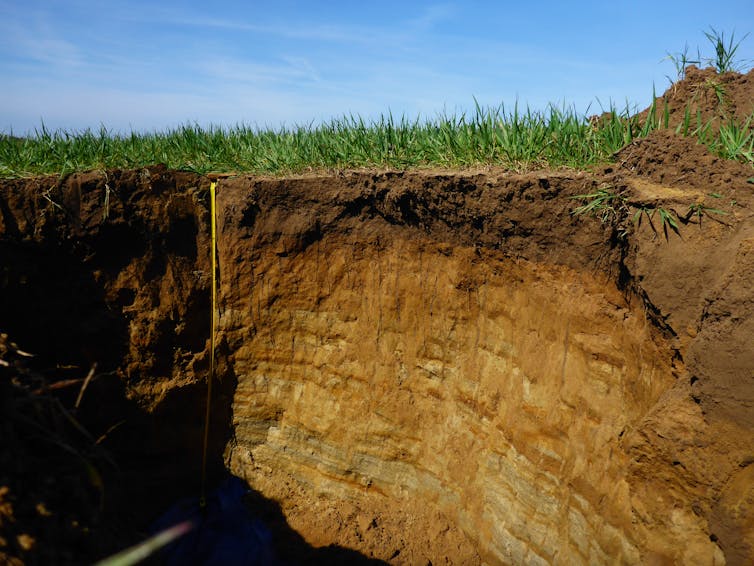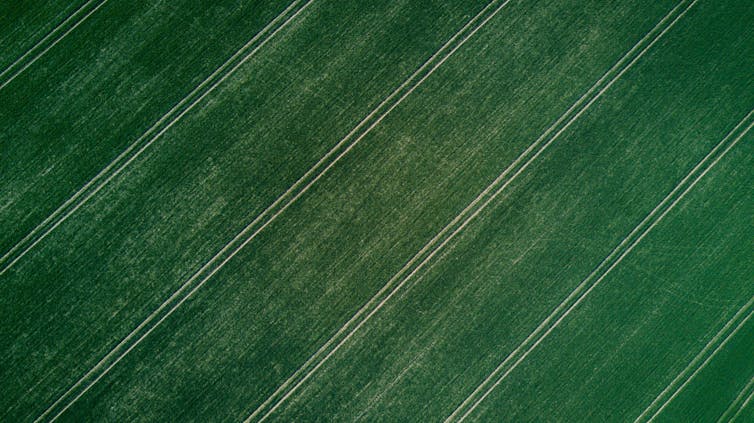Soil is our best ally in the fight against climate change – but we’re fast running out of it

Dan Evans, Author provided
By Dan Evans, Lancaster University
Take a handful of soil and hold it up to your nose. That fresh, earthy aroma is organic matter, part of which is carbon. What you can smell is the whiff of a solution for dealing with climate change.
Global soil resources contain more organic carbon than the world’s atmosphere and all of its plants combined. When plants photosynthesise, they take carbon out of the atmosphere and when they die, that carbon is returned to the soil.
Storing more carbon in the soil helps to remove carbon dioxide from the atmosphere. But it also helps release nutrients for plant growth and improves the structure of the soil, enhancing how well it retains water.
Read more:
France has a great plan for its soil – and it’s not just about wine
Maintaining these soil ecosystem services will become more important over the next few decades. By 2050, the global population is estimated to soar to more than 9 billion, and that will mean a much greater demand on the world’s soil. In business, when demand for a product grows, you increase its production. But for soil, it’s a different story.
Soil is largely made at the bedrock deep below the Earth’s surface, and it is a slow process. Across the world, soil erosion, which is accelerated by some agricultural activities, is exceeding the rates at which new soils can form. As a soil thins, its productivity wanes. Less soil means a lower capacity to store nutrients, water and carbon. The long-term ability for soils to slow climate change and feed the world is under threat.

Jaromír Kavan/Unsplash, CC BY-SA
Tick tock from soil to rock
How many years might the world’s soils have left to support crop production? To store and purify water? To sequester enough atmospheric carbon to halt the climate emergency? Until now, there have been few measurements of how fast soil is being formed and eroded on land currently supporting agriculture. Efforts to understand this have been similar to forecasting a bank balance using just the expenditures.
Our research is the first in the world to make a clear scientific estimate of soil lifespans, using measured rates of soil formation and erosion, giving farmers and scientists a more accurate idea of how sustainable the world’s soil resources are.
Measuring soil formation at an arable farm in Nottinghamshire, UK, we estimated that the uppermost 30 centimetres could be eroded in as little as 138 years, with the underlying sandstone bedrock emerging in 212 years. This may not seem like an urgent crisis. But given that these soils have been functioning for the last 10,000 years, this projection could be the final 1% of their lifespan.
In other regions of the world, soils that have been subject to centuries of intensive agriculture have already thinned significantly. In sub-Saharan Africa, Asia, and Latin America and the Caribbean, the threat of soil erosion is high and soil functioning is considered to be deteriorating.
In these regions, where rates of soil erosion are often greater than those for the UK, soil lifespans may be much shorter. Since the demands on soil will only intensify as the global population grows, societies will need to adapt to reverse the trajectory of soil thinning and, instead, find ways of thickening soils and extending their lifespans.
Read more:
Our new research is tracing the development of the world’s vital non-living nature
Saving earth on Earth
Discuss soil conservation and you join a conversation sustained over thousands of years. Nearly every civilisation has, to varying degrees, contributed to the debate. As a result, we’re lucky today to have an extensive and well-tested toolkit at our disposal with which to save the world’s soils.
These include relatively minor changes in agricultural practices. For example, planting crops across, rather than down, a hillslope can interrupt the flow of water and stop it from picking up and removing soil. Planting trees and ensuring soils are always vegetated with a cover crop such as clover between cropping seasons can also slow water and trap soil.

Mimi Di Cianni/Unsplash, CC BY-SA
In May 2019, I attended the Global Symposium on Soil Erosion in Rome. A lot of water (and soil) has passed underneath the Pons Fabricius bridge since ancient Roman farmers stood and discussed soil conservation over their hedgerows.
The symposium brought not only farmers together, but scientists, government officials, and land managers too. Soil erosion is a global issue, so conversations between people with different backgrounds and skills are essential. But the message that emerged from the symposium was relatively simple. For a decent future for all, we must save the world’s soils. And the clock is ticking.![]()
Dan Evans, PhD Researcher in Soil Science, Lancaster University
This article is republished from The Conversation under a Creative Commons license. Read the original article.